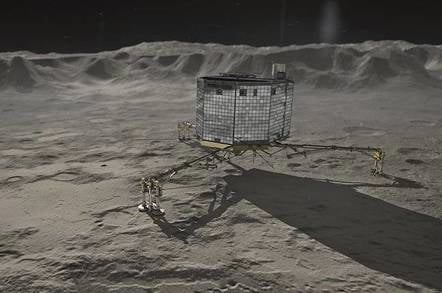Now we know why Philae phouled up comet landing
Plans for Rosetta probe to crash land on comet next year

Exactly a year ago, mankind's first ever attempt to land on a comet did not go according to plan - and the European Space Agency (ESA) has just released a report explaining why.
The Philae lander was carried for 10 years on the Rosetta probe as it built up speed and approached Comet 67P/Churyumov-Gerasimenko. But when it was released to land on the comet it bounced off and ended up far from its intended position, unable to charge its solar panels.
The three-legged lander was supposed to drop down to the comet's surface and fire harpoons into the surface to secure it; a small thruster providing enough force to counter the recoil. Once in place, ground ice screws would then lock the probe down. Sadly, none of that happened.
The ESA operators knew they had problems before the Philae landing was attempted. The thruster refused to arm itself ahead of the attempt. It's thought a dodgy seal caused the failure, although it may have been sensor problems. ESA went ahead with the landing attempt regardless.
The harpoons failed to fire and the lander started to bounce across the comet's surface, out of control. The agency released a simulation of its path.
"It seems that the problem was either with the four 'bridge wires' taking current to ignite the explosive that triggers the harpoons, or the explosive itself, which may have degraded over time," explained Stephan Ulamec, Philae lander manager. "In any case, if we can regain contact with Philae, we might consider an attempt to retry the firing."
Despite not being able to recharge its batteries, Philae managed to perform 80 per cent of its scheduled scientific experiments before being shut down. Since then there have been sporadic signals from the lander, but nothing concrete.
"We had already determined that one of Philae's two receivers and one of the two transmitters were likely no longer working," said technical manager Koen Geurts, "and it now seems that the other transmitter is suffering problems. Sometimes it did not switch on as expected, or it switched off too early, meaning that we likely missed possible contacts."
As the comet reached its closest point to the Sun, the Rosetta probe was forced to retreat out of range of Philae's radios because of the amount of offgassing as the cosmic snowball heated up. Now that the comet is heading back out into space, Rosetta is approaching again and is now 170 kilometers from the surface and heading back in range.
Sooner or later the Rosetta probe is going to run out of power as it speeds away from the Sun, and the ESA crew had planned to leave it in permanent orbit. But now there's a new plan: another attempted landing.
"Next year, we plan to do another far excursion, this time through the comet's tail and out to 2000km," said Matt Taylor, ESA's Rosetta project scientist. "To complement that, we hope to make some very close fly-bys towards the end of the mission, as we prepare to put the orbiter down on the comet."
The probe will start a series of maneuvers in August that will see it swoop as low as a kilometer from the comet's surface. It will then move further away and slow down for a landing attempt in September.
"Landing Rosetta on a comet will be a fitting ending to this incredible mission," says Patrick Martin, ESA's Rosetta mission manager. ®








 User Center
User Center My Training Class
My Training Class Feedback
Feedback











